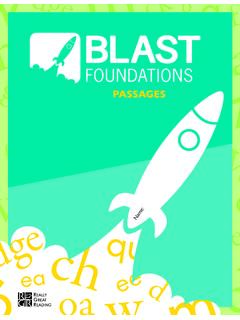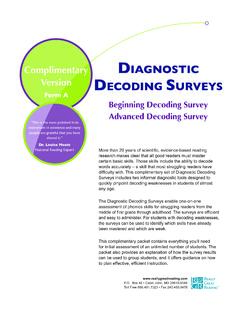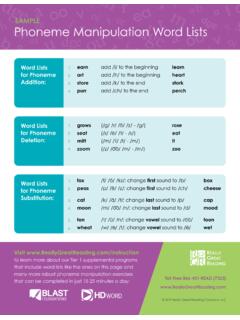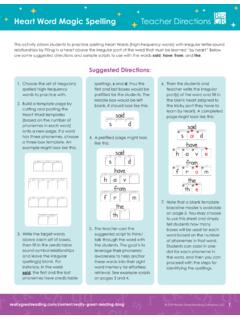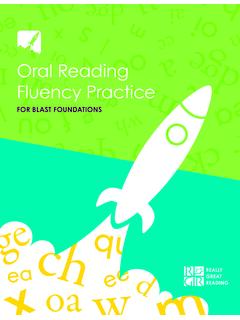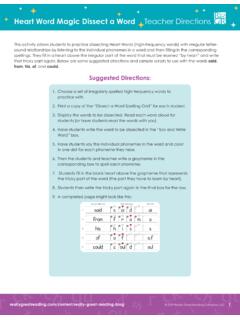Transcription of Oral Reading Fluency Practice
1 oral Reading Fluency PracticeFOR HD WORD, PHONICS BLITZ, AND PHONICS BOOST 2020 Really Great Reading Company, LLC 2 Table of ContentsHow to Use the Passages for Fluency Practice 3 4 Sample Tracking Chart 5 Tracking Chart 6 Passages 7 Passage 1: The Lungs 8 Passage 2: Nazca Line Drawings 10 Passage 3: The Wright Brothers 12 Passage 4: Climates 14 Passage 5: Pompeii 16 2020 Really Great Reading Company, LLC 3 How to Use the Passages for Fluency PracticeFluency Passages Quick OverviewThe Fluency Passages are expository, non-controlled, connected text similar to what students might read in their content-area classes. Reading these passages allows students a chance to Practice the strategies they are learning in their Boost or Blitz lessons. Using the Passages for oral Reading Fluency PracticeThe students goal in oral Reading is to read with an accuracy rate of 98% or higher.
2 When students read accurately, their comprehension improves because they are correctly interpreting the words on the page. When a student s miscues, or mistakes, are identified while Reading aloud, it helps emphasize the importance of Reading accuracy. Students learn to balance the two most important aspects of Fluency , which are accuracy and speed. Among other positive net effects, this helps students learn how not to make those same mistakes in future children read accurately, their comprehension improves because they are correctly interpreting the words on the page. Helping your child identify incorrectly read words as they read aloud helps them understand how important it is to read each word correctly. The two most important pieces of Fluency are accuracy and speed. The focus should always be on accuracy first, and then speed can be addressed. Using the oral Reading procedure described below will help your child achieve this Cold Read (First Reading , Beginning of the Week)It would be useful to print two copies of the passage before starting so that you and your child can each have your own copies.
3 You will be marking up mistakes and words read on your the passage for the unit your child is currently working on, have your child first read the passage for one minute, starting with a preview of the Words to Preview and Point and Say words at the top of the page, at the beginning of the week. During this read:1. Review the Words to Preview and their definitions as well as the Point and Say words with your child. This will help your child read these words more smoothly when he or she encounters them in the The child reads for just one minute independently and aloud. Stop your child at one minute and mark the last word they read at the one-minute As your child reads, mark any errors they make (skipped words, incorrectly read words, added words). a. If the child reads a word incorrectly or skips a word, cross that word out. However, if your child corrects the word on his or her own, do not count it as an : Date: 2020 Really Great Reading Company, LLC 8 Passage 1: The LungsWords to Preview1.
4 Oxygen a colorless, odorless gas that is part of the air we breathe in. People and animals need oxygen to carbon dioxide a colorless, odorless gas that is the air we breathe out. People and animals breathe out carbon deflate to lose air and get smaller. Tires deflate when they have a leak and the air inside contraction occurs when a muscle or muscle fiber shortens and tightens. When a muscle contraction is painful, we sometimes call it a trachea the windpipe; the main tube or airway used to breathe. When you breathe, oxygen goes through your trachea and into your and SayheartaccidenthealthybreatheThe LungsNote: Hyphenated words count as one use our lungs to breathe. When we breathe, our body gets the oxygen it needs to 17 stay alive. 19 Our lungs are in our chests, near our hearts. They take up most of the area in our chests. 38 We have two lungs, one on each side.
5 The lungs breathe in oxygen and breathe out carbon 55 dioxide. Our lungs are necessary to life. Our hard, bony ribs keep our lungs safe. 70 When we breathe in, our lungs fill with air, like balloons, and our chests get bigger. When 87 we breathe out, our lungs deflate. The air leaves our lungs, and our chests get smaller. 103We breathe in and out all the time without having to think about it. If we try to hold 122 our breath for a long time, our brain will soon make us start breathing again. 137 People usually breathe in and out about twenty times a minute. If we run fast, our lungs 154 need more oxygen, so we breathe faster about eighty times a minute. The heart and the 170 2020 Really Great Reading Company, LLC 4 How to Use the Boost/Blitz Passages for Fluency Practiceb. If your child adds a word, write the word in where it was Calculate your child s Accuracy Percentage and Words Correct Per Minute using the Calculation Box at the bottom of the passage.
6 Chart these scores using the chart on p. 6 of this document. a. Calculating Words Correct Per Minute (the Calculation Box will walk you through this):Number of words at the 1-minute markNumber of miscues/mistakesWords Correct Per MinuteUse the line count numbers at the end of each line to help you determine not include words Calculating Accuracy Percentage (the Calculation Box will walk you through this):Words Correct Per MinuteNumber of total words read at the 1-minute markAccuracy Percentagec. Charting with the Tracking Charti. Record the date in the Date boxii. Record the Accuracy % for the passage your child just readiii. Have your child color in the vertical bar from the bottom of the section UP TO their accuracy percentage for the passage your child just read iv. Record the Words Correct Per Minutev. Have your child color in the vertical bar from the bottom of the section UP TO their WCPMP ractice Reads ( Reading Throughout the Week)Throughout the week, have your child Practice Reading the same passage aloud independently or to you.
7 If possible, have them read aloud to you so you can address errors. For these Practice reads, you should allow your child to read the whole passage and not stop them at the 1-minute mark, so they are able to Practice Reading all the words in the passage. These Practice reads are NOT recorded on the Tracking Read (Last Reading , End of the Week)Follow the same procedure as in the Cold Read, including calculating the Accuracy Percentage and Words Correct Per Minute and then charting them. The goal is for both of these numbers to increase by the end of the week; however, be aware that as accuracy increases, sometimes their speed (WCPM) will decrease. This is not a problem. Accuracy is the most important aspect of Fluency ; speed will come with more Practice of accurate Reading . 2020 Really Great Reading Company, LLC 5 Sample Tracking ChartName: Date10/1010/410/510/610/910/1110/1410/18 10/2210/2310/2610/2710/2810/3111/03 Accuracy PercentageGoal is 98% or betterAccuracy91 %92 %89 %93 %95 %97 %96 %99 %98 %100%98 %99 %98 %100%98 %100%99%98%97%96%95%94%93%92%91%90% or belowWords Correct per MinuteWCPM635964687382898783959295981051 17105 or above110 114105 109100 10495 9990 9485 8980 8475 7970 7465 6960 6455 5950 5445 4940 4435 3930 3425 2920 2415-1910-14below 10 2020 Really Great Reading Company, LLC 5 Sample Tracking ChartName.
8 Date10/1010/410/510/610/910/1110/1410/18 10/2210/2310/2610/2710/2810/3111/03 Accuracy PercentageGoal is 98% or betterAccuracy91 %92 %89 %93 %95 %97 %96 %99 %98 %100%98 %99 %98 %100%98 %100%99%98%97%96%95%94%93%92%91%90% or belowWords Correct per MinuteWCPM635964687382898783959295981051 17105 or above110 114105 109100 10495 9990 9485 8980 8475 7970 7465 6960 6455 5950 5445 4940 4435 3930 3425 2920 2415 -1910 -14below 10 2020 Really Great Reading Company, LLC 6 Tracking ChartName: DateAccuracy PercentageGoal is 98% or betterAccuracy % % % % % % % % % % % % % % %100%99%98%97%96%95%94%93%92%91%90% or belowWords Correct per MinuteWCPM105 or above110 114105 109100 10495 9990 9485 8980 8475 7970 7465 6960 6455 5950 5445 4940 4435 3930 3425 2920 2415 -1910 -14below 10 Name: Date: 2020 Really Great Reading Company, LLC 8 Passage 1: The LungsWords to Preview1.
9 Oxygen a colorless, odorless gas that is part of the air we breathe in. People and animals need oxygen to carbon dioxide a colorless, odorless gas that is the air we breathe out. People and animals breathe out carbon deflate to lose air and get smaller. Tires deflate when they have a leak and the air inside contraction occurs when a muscle or muscle fiber shortens and tightens. When a muscle contraction is painful, we sometimes call it a trachea the windpipe; the main tube or airway used to breathe. When you breathe, oxygen goes through your trachea and into your and SayheartaccidenthealthybreatheThe LungsNote: Hyphenated words count as one use our lungs to breathe. When we breathe, our body gets the oxygen it needs to 17 stay alive. 19 Our lungs are in our chests, near our hearts. They take up most of the area in our chests. 38 We have two lungs, one on each side.
10 The lungs breathe in oxygen and breathe out carbon 55 dioxide. Our lungs are necessary to life. Our hard, bony ribs keep our lungs safe. 70 When we breathe in, our lungs fill with air, like balloons, and our chests get bigger. When 87 we breathe out, our lungs deflate. The air leaves our lungs, and our chests get smaller. 103We breathe in and out all the time without having to think about it. If we try to hold 122 our breath for a long time, our brain will soon make us start breathing again. 137 People usually breathe in and out about twenty times a minute. If we run fast, our lungs 154 need more oxygen, so we breathe faster about eighty times a minute. The heart and the 170 2020 Really Great Reading Company, LLC 9 Subtract: Number of ErrorsEquals: Words Correct per Minute (WCPM)Accuracy Percentageabc%Number of Words at One-Minute Markc aSubtract: Number of ErrorsEquals: Words Correct per Minute (WCPM)Accuracy Percentageabc%Number of Words at One-Minute Markc aCold Read*Warm Read**See pages 3-4 for information about Cold Reads and Warm work together.
